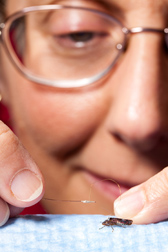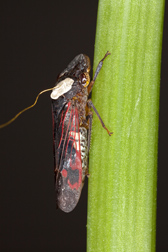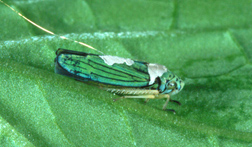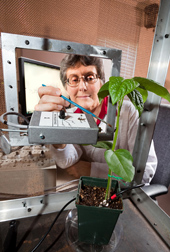New Tool Opens a Bigger Window to Insect-Plant Warfare
|
|
When an aphid, leafhopper, or psyllid lands on a plant to feed, it begins a process of chemical warfare. As piercing-sucking insects, they use needle-like stylets to insert saliva into plant tissues and open a pathway to ingest fluids critical to the plant’s survival. When punctured, the plant senses the attack and secretes proteins and other chemical defenses to prevent fluids from being pulled out, thus creating a stress on the plant. This warfare costs growers billions of dollars each year in lost ornamentals, vegetables, citrus, and other important agricultural crops.
Because much of the action takes place in the plant’s interior, a scientific tool called an “electrical penetration graph” (EPG) is critical for peering into the process. To use it, researchers connect the insect and plant to an electronic monitor that, like an electrocardiogram, reads electrical charges produced by tiny changes in voltage that occur as the insect feeds. A new type of EPG, developed by Elaine Backus, an ARS entomologist at the San Joaquin Valley Agricultural Sciences Center, in Parlier, California, and the late William Bennett, formerly from the University of Missouri, is giving scientists the clearest window yet into the wars waged between piercing-sucking insects and the plants they infest. Because these insects are often carriers of plant pathogens that are transmitted through feeding, EPG can also illuminate how pathogens are injected into the plant to start the infection process.
The new EPG—called the “AC-DC correlation monitor”—is much more versatile than any of its predecessors and is currently being used by researchers around the country in ways expected to broaden our understanding of how plant-feeding insects cause so much damage. “We’ve expanded the flexibility of the current technology so that we’re now able to evaluate any insect that pierces or breaks the surface of a plant and study the feeding mechanisms and the pathogen-inoculation process in more detail,” Backus says.
|
|
She and Bennett described their AC-DC monitor in a 2009 issue of the Journal of Insect Physiology. Backus also used it in a series of studies published in the Annals of the Entomological Society of America. These studies focusedon the critical role that saliva plays when the glassy-winged sharpshooter injects the Pierce’s disease bacterium, Xylella fastidiosa, into grapes. Backus believes that the saliva loosens bacteria living in the gut and stylets and carries them into the plant when the mixture is “spit up” during feeding. That inoculation process begins the spread of the disease throughout the plant. Backus could not have gained these insights without the AC-DC monitor.
Backus has promoted the monitor’s versatility at scientific workshops and conferences. In recent years, Bennett built more than a dozen monitors worldwide for scientists who were willing to reimburse him for the costs. Among its fans are researchers at Oklahoma State University, who are using it to study how plant pathogens are injected into watermelons by squash bugs and into corn by corn leafhoppers.
“We’ve found that you can use it to gather all sorts of information,” says Astri Wayadande, a vector entomologist at Oklahoma State University.
Having such technology should prove useful to entomologists and to plant breeders. A goal for breeders is to develop plants with genes that make them capable of resisting pathogens. To find those genes, it would help to learn more about the pathogen-inoculation process so that, ideally, you could identify steps in the process that can be partially or completely blocked, either by silencing or turning on the right genes.
|
|
A Scientific Workhorse
At least seven different EPG systems have been made by scientists around the world. Over the past 30 years, the monitors have earned a reputation as a workhorse among researchers who study aphids and a handful of other piercing-sucking insects. Scientists have reported on them in more than 400 peer-reviewed papers.
To use them, researchers glue one end of a gold wire to the insect’s dorsal area (its back) and insert another wire into the moist soil around the plant. This establishes a continuous electrical circuit through the monitor that can detect even miniscule changes in voltage that occur when the insect pierces the plant, releases saliva, or draws juice (ingests) from the plant into its digestive system.
Fluids like saliva carry electrical charges, and the movement of saliva into the plant causes the levels of those charges to fluctuate. That in turn produces waveforms that scientists can read to decipher details about the feeding and pathogen-inoculation process.
Waveforms are also produced by fluid fluctuations caused by movements of the insect’s internal valves and pumps as it feeds or by the breaking of plant cell membranes. When researchers study different species of insects, they correlate the waveforms produced by each species to different steps in the feeding process, such as the insertion of saliva, the initial tasting, and ingestion. For each insect, there are unique changes in waveforms from ingestion, salivation, and stylet movement. “It is a window into the internal mechanisms that the insect uses when it feeds and into the plant responses to the feeding,” Backus says.
The New Monitor’s Advantages
Traditionally, monitors have been designed to work with either AC or DC current. Because of the physics that govern electricity and the flow of electrical current, researchers have gotten the best results when using AC monitors to study larger insects and DC monitors to study smaller ones. Ideally, a monitor should be capable of studying a variety of insect sizes.
As the name implies, the AC-DC monitor incorporates features from both AC and DC monitors, making it more versatile. The user can adjust the settings to the size of the insect being studied. They can use it to study all kinds of insects—not just plant feeders—to see what happens when a tick, mite, mosquito, bed bug, deer fly, or any biting or chewing insect pierces the surface of a plant or animal when it feeds, Backus says.
Entomologists will be able to view the feeding process in detail for more insects than ever before and compare the feeding of pathogen-bearing insects with those that are pathogen-free. Many pathogens, both animal and plant, affect the insects that carry them as well as the plants or animals they infect.
Wayadande is using the monitor to study how squash bugs transmit Serratia marcescens,the bacterium that causes cucurbit yellow vine disease, to watermelon and other cucurbits. She hopes to find cultivars that breeders can use to develop commercial varieties that resist the pathogen. “We don’t really understand how squash bugs feed, how they damage the plant, and how they inoculate it with plant pathogenic bacteria and cause disease. The monitor helps us study all of these things,” she says.
Wayadande also used the monitor to study and publish research on how leafhoppers infect corn with corn stunt spiroplasma, a common corn pest. Squash bugs are much larger than leafhoppers, so before Backus and Bennett’s monitor came along, Wayadande says she probably would have had to use two different monitors to effectively monitor the two insects. But with the AC-DC monitor, she collected quality data on both.
“It’s a wonderfully versatile system,” she says.—By Dennis O'Brien, Agricultural Research Service Information Staff.
This research is part of Plant Diseases, an ARS national program (#303) described at www.nps.ars.usda.gov.
Elaine Backus is in the USDA-ARS Crop Diseases, Pests, and Genetics Unit, 9611 S. Riverbend Ave., Parlier, CA 93648, (559) 596-2925.
"New Tool Opens a Bigger Window to Insect-Plant Warfare" was published in the May/June 2012 issue of Agricultural Research magazine.










